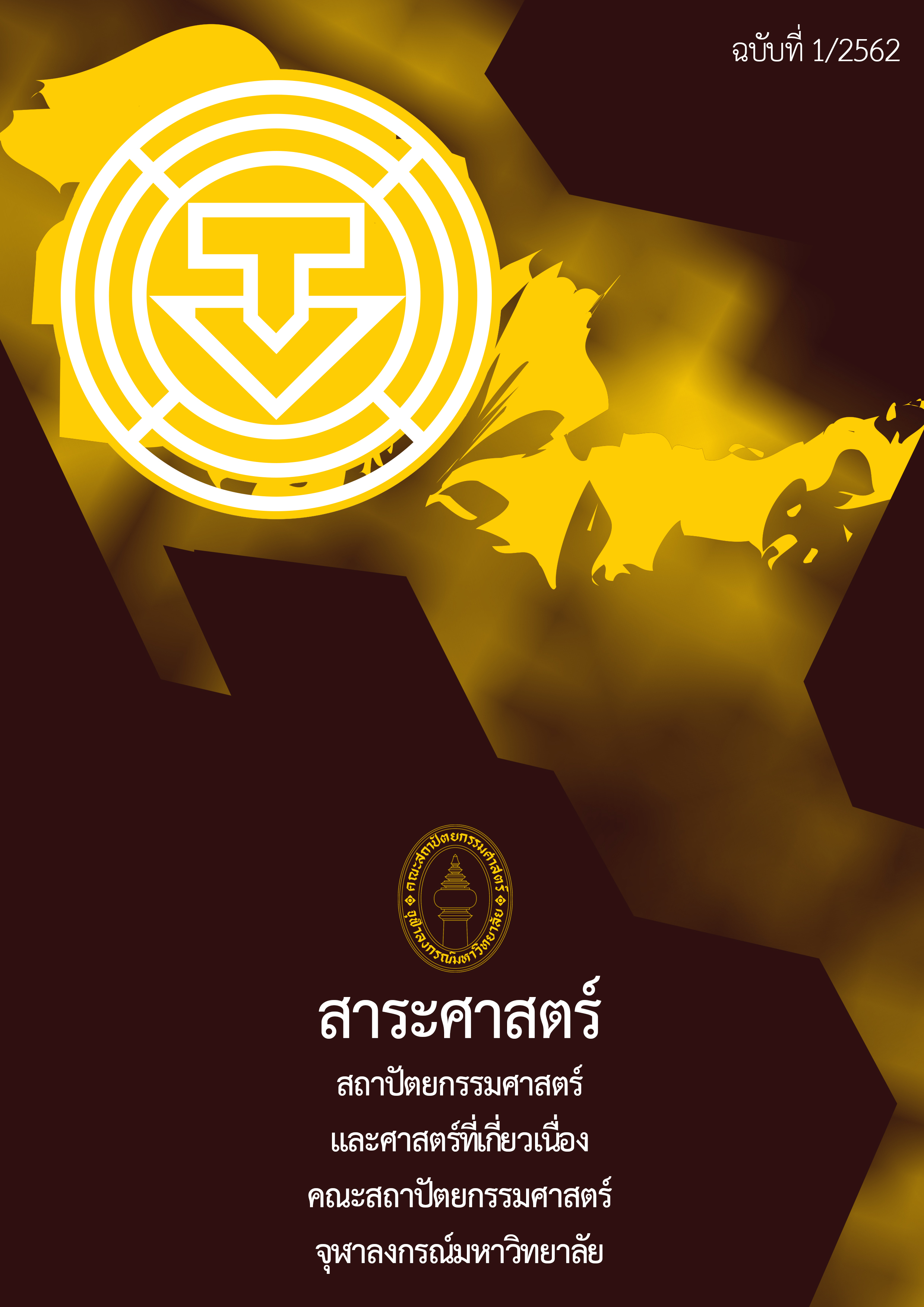การประเมินต้นไม้ในเมือง: กรณีศึกษา ต้นไม้ริมทางบริเวณคูเมือง จังหวัดเชียงใหม่
Main Article Content
บทคัดย่อ
การศึกษานี้เป็นการรวบรวมแนวคิด และวิธีการที่เกี่ยวข้องกับการประเมินคุณค่า และมูลค่าของต้นไม้สาธารณะในเมือง โดยมีวัตถุประสงค์ในการที่จะสร้างเครื่องมือประเมินค่าต้นไม้ และนำไปทดสอบกับพื้นที่กรณีศึกษาต้นไม้สาธารณะริมทาง บริเวณคูเมืองเทศบาลนครเชียงใหม่ จังหวัดเชียงใหม่ โดยวิธีการศึกษาจากการทบทวนวรรณกรรมที่เกี่ยวกับ แนวคิด ทฤษฎีที่เกี่ยวข้องกับหลักเกณฑ์การประเมินคุณค่า และมูลค่าของต้นไม้สาธารณะในเมืองรายต้น นำผลจากการศึกษาไปวิเคราะห์ เปรียบเทียบ หาความเหมือน และแตกต่างกันของปัจจัยและเกณฑ์แล้วสรุปเป็นแบบบันทึกการสำรวจ เพื่อนำไปใช้ในการเก็บข้อมูลภาคสนาม ในการสำรวจคุณภาพ และคุณสมบัติของต้นไม้ที่เลือกทำการประเมินและสอบถามจาก นักวิชาการ และคนในชุมชนที่อาศัยอยู่รอบบริเวณภายในเขตคูเมืองชั้นนอก และชั้นในของเทศบาลนครเชียงใหม่ ทำให้ทราบว่ามีต้นไม้ยืนต้น จำนวน 7 ชนิดคือ ต้นโพ (Ficus Religiosa) ต้นฉำฉา (Albizia saman) ต้นไทรกร่าง (Ficus altissim) ต้นยางยา (Dipterocarpus alatus flabellifer) ต้นสัก (Tectona grandis) ต้นตาล (Borassus flabellifer) และต้นลาน (Corypha lecomtei) ที่มีผลต่อทัศนียภาพ และมีความโดดเด่น เป็นที่จดจำ และได้ทดลองประเมินคุณค่าของต้นไม้ที่มีความสำคัญเหล่านี้ จำนวน 9 ต้น พบว่ามูลค่าของต้นไม้แปรผันตามระดับของคุณค่าที่ประเมินจากเกณฑ์ของปัจจัยทางด้าน โครงสร้างต้นไม้ คุณลักษณะทางกายภาพต้นไม้ และสภาพแวดล้อมของพื้นที่โดยรอบต้นไม้ สรุปผลการศึกษาครั้งนี้ วิธีการประเมินคุณค่า และมูลค่าต้นไม้สาธารณะในเมือง ประกอบด้วยวิธีการประเมิน 2 แนวทางได้แก่ วิธีการประเมินผลประโยชน์ และวิธีการประเมินต้นทุนของต้นไม้เพื่อให้มูลค่าสุทธิของต้นไม้ ครอบคลุมคุณค่าหลากมิติ และคำนึงถึงผลกระทบด้านลบของต้นไม้ที่เกิดขึ้น ณ ปัจจุบัน นำไปสู่การเสนอแนวทางการจัดการต้นไม้ให้เหมาะสมกับสภาพแวดล้อม เพื่อความยั่งยืนของการจัดการ และการอนุรักษ์ต้นไม้สาธารณะในเมืองอย่างยั่งยืนต่อไป
Article Details
เอกสารอ้างอิง
Ciecko L., Tenneson, K., Dilley, J and Wolf, K. Seattle's Forest Ecosystem Values: Analysis of the Structure, Function, and Economic Benefits. Seattle, WA.: Green Cities Research Alliance, 2012.
City of Melbourne. “Tree Valuations in the city of Melbourne.” Melbourne Australia.: City of Melbourne. Accessed June 22. 2016. https://www.melbourne.vic.gov.au/SiteCollectionDocuments/Tree-valuations.DOC.
Cullen, S. "Putting a Value on Trees – CTLA Guidance and Methods." Arboricultural Journal 30 (2007): 21-43.
Dwyer J. F., Schroeder, H.W., Mcpherson, E.G. and Rowntree, R.A. "Assessing the Benefits and Costs of the Urban Forest." Journal of Arboriculture 18, 5 (September 1992): 227-234.
Greening Landscape and Tree management Section Development Bureau. Guidelines for Tree Risk Assessment and Management Arrangment. 8th ed. Hong Kong: People Tree Harmony, 2015.
Helliwell, R. Visual Amenity Valuation of Tree and Woodlands: The Helliwell System. n.p.: Aboricultural Association, 2008.
International Society of Arboriculture. “Benefits ofTtrees.” Accessed May 20, 2016.
https://www.treesaregood.org/portals/0/docs/treecare/benefits_trees.pdf.
Jim, C. Y. "Formulaic Expert Method to Integrate Evaluation and Valuation of Heritage Trees in Compact City." Environmental Monitoring and Assessment 116, 1: 53-80.
Kane B. and Kirwan J. "Value, Benefits, and Costs of Urban Trees." Virginia Cooperative Extension (2009): 1-2.
McPherson, E. G. "Benefit-Based Tree Valuation." Arboriculture & Urban Forestry 33, 1: (January 2007): 1-11.
McPherson E.G., Simpson, J.R., Peper, P.J. and Xiao, Q. "Benefit-Cost Analysis of Modesto's Municipal Urban Forest." Journal of Aboriculture 25, 5 (September 1999): 235-248.
Nowak D. J., Crane, D.E. and Dwyer, J.F. "Compensatory Value of Urban Trees In The United States." Journal of Aboriculture 28, 4: 194-199.
Nowak D. J., Stevens, J.C., Crane, D.E. and Hoehn, R.E. "The Urban Forest Effects (UFORE) Model: Field Data Collection Manual." ReseachGate (August 2003): 1-22.
USDA Forest Service. Davey Tree Expert Company. Arborday Foundation. Society of Municipal Arborists.
International Society of Arboriculture. “Casey Trees, and SUNY College of Environmental Science and Forestry. I-Tree Eco International.” Accessed June 18, 2016. https://www.itreetools.org/tools/i-tree-eco/i-tree-eco-international.
Vogt J., Hauer, R.J. and Fischer, B.C. "The Costs of Maintaining and Not Maintaining the Urban Forest: A Review of the Urban Forestry and Aboriculture Literature." Arboriculture & Urban Forestry 41, 6 (2015): 293-323.
โกวิทย์ วาปีศิลป์. "ไม้พื้นถิ่นกับงานภูมิสถาปัตยกรรม." ใน งานประชุมวิชาการระดับชาติ "โฮมภูมิ" ครั้งที่ 2 อยู่อย่างยั่งยืน (Sustainable Living). ขอนแก่น: คณะสถาปัตยกรรมศาสตร์ มหาวิทยาลัยขอนแก่น, 2558.
จามรี อาระยานิมิตสกุล. "การศึกษาไม้ยืนต้นริมถนนและริมคลองในเขตกรุงรัตนโกสินทร์ ในสมัยรัชกาลที่ 5." วารสารวิชาการคณะสถาปัตยกรรมศาสตร์ จุฬาลงกรณ์มหาวิทยาลัย (2558): 19-32.
จามรี อาระยานิมิตสกุล. โครงการศึกษาและสำรวจไม้ยืนต้นในพระจุฑาธุชราชฐานเกาะสีชัง จังหวัดชลบุรี: รายงานฉบับสมบูรณ์ พ.ศ. 2548. กรุงเทพฯ: คณะสถาปัตยกรรมศาสตร์ จุฬาลงกรณ์มหาวิทยาลัย.
เดชา บุญค้ำ. ต้นไม้ใหญ่ในงานก่อสร้างและพัฒนาเมือง. กรุงเทพฯ: สำนักพิมพ์แห่งจุฬาลงกรณ์มหาวิทยาลัย, 2543.
ธนาคารเพื่อการเกษตรและสหกรณ์การเกษตร. ธนาคารต้นไม้ วิถีแห่งความพอเพียง มั่งคั่ง ยั่งยืน. กรุงเทพฯ: ธนาคารเพื่อการเกษตรและสหกรณ์การเกษตร, 2556.
บรรจง สมบูรณ์ชัย. "การฟื้นฟูต้นฉําฉา ถนนสายวัฒนธรรมเชียงใหม่ – สันกําแพง จังหวัด
เชียงใหม่." ใน การประชุมวิชาการภูมิทัศน์และสิ่งแวดล้อม ครั้งที่ 1 no. 1: 193-210. ปทุมธานี: คณะสถาปัตยกรรมศาสตร์และการผังเมือง, 2556.
เยาวนิตย์ ธาราฉาย. Monumental Trees in Chiang Mai. กรุงเทพฯ: สำนักงานนโยบายและแผนทรัพยากรธรรมชาติและสิ่งแวดล้อม, 2554.


